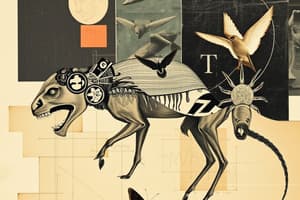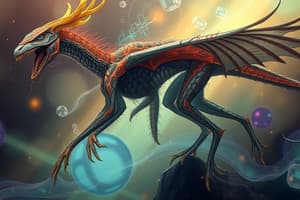Podcast
Questions and Answers
What does the term 'Systematic, Taxonomy, and Nomenclature' refer to?
What does the term 'Systematic, Taxonomy, and Nomenclature' refer to?
- Science of naming groups of organisms (correct)
- Inferring evolutionary relationships only
- Classifying organisms only
- Process of collecting organisms
What is Binomial Nomenclature?
What is Binomial Nomenclature?
A system of naming in which each species is assigned a two-part name consisting of its genus (first) and species (last).
Who devised the Linnaean System of Classification?
Who devised the Linnaean System of Classification?
Carolus Linnaeus
What are the most inclusive and least inclusive categories in the Linnaean Hierarchy?
What are the most inclusive and least inclusive categories in the Linnaean Hierarchy?
What are the three criteria for recognizing species?
What are the three criteria for recognizing species?
What does the Biological Species Concept (BSC) state?
What does the Biological Species Concept (BSC) state?
Which of the following is a criticism of the Biological Species Concept?
Which of the following is a criticism of the Biological Species Concept?
What is the Evolutionary Species Concept (ESC)?
What is the Evolutionary Species Concept (ESC)?
What does the Cohesive Species Concept (CSC) imply?
What does the Cohesive Species Concept (CSC) imply?
What is the Phylogenetic Species Concept (PSC)?
What is the Phylogenetic Species Concept (PSC)?
What is a species?
What is a species?
How do we originally put organisms into groups?
How do we originally put organisms into groups?
What is phylogeny?
What is phylogeny?
How can we explain morphological similarities between unrelated species?
How can we explain morphological similarities between unrelated species?
What is a character in the context of classification?
What is a character in the context of classification?
What is the difference between cladistic analysis and phylogenetic analysis?
What is the difference between cladistic analysis and phylogenetic analysis?
What does polarity signify in classification?
What does polarity signify in classification?
What is an out-group?
What is an out-group?
What is a paraphyletic group?
What is a paraphyletic group?
What is a polyphyletic group?
What is a polyphyletic group?
What defines a monophyletic group?
What defines a monophyletic group?
What is polyphyly?
What is polyphyly?
Flashcards are hidden until you start studying
Study Notes
Classification Principles
- Systematic, taxonomy, and nomenclature are essential in organizing and naming groups of organisms, revealing their evolutionary connections.
Binomial Nomenclature
- Each species adopts a two-part naming system, consisting of the genus (first part) and species (second part), typically italicized or underlined.
Linnaean Classification System
- Developed by Carolus Linnaeus, this system categorizes life into hierarchies: Domain, Kingdom, Phylum, Class, Order, Family, Genus, and Species.
Hierarchical Inclusion
- The Domain is the most inclusive category, while Species is the least inclusive in the Linnaean hierarchy.
Criteria for Species Recognition
- Common descent traces back to a shared ancestor.
- Organisms form the smallest distinct group with shared ancestry.
- A reproductive community is identified in sexually reproducing species.
Biological Species Concept (BSC)
- Defines species as reproductive communities within specific ecological niches.
Criticisms of BSC
- Questions arise regarding interbreeding capabilities among recent common ancestors.
- Asexual organisms are often excluded, and reproductive isolation varies in strength.
Evolutionary Species Concept (ESC)
- Describes species as ancestor-dependent lineages, distinct yet sharing evolutionary trends, applicable to both sexual and asexual reproduction.
Cohesive Species Concept (CSC)
- Focuses on a shared ancestral genome modified by genetic drift, gene flow, and natural selection.
Phylogenetic Species Concept (PSC)
- Defines species based on irreducible groupings, distinctiveness, and ancestry separation patterns.
Understanding Species
- A species comprises interbreeding individuals with a common ancestor, isolated from other groups.
Grouping Organisms
- Initially based on morphology and today on homologies, indicating hierarchical relationships among groups.
Phylogenetic Analysis
- Incorporates a time scale and common ancestry to transform a cladogram into a phylogenetic tree.
Explaining Morphological Similarities
- Analogies or homoplasies arise from convergent evolution, where unrelated species develop similar traits.
Character Definition
- A character is any trait used to infer interrelationships, which can be morphological, behavioral, or biochemical.
Cladistic and Phylogenetic Analysis
- Cladistic analysis involves creating cladograms, while phylogenetic analysis focuses on constructing evolutionary trees.
Polarity in Character States
- Refers to the determination of whether character states are ancestral or derived, along with their variations.
Understanding Groups
- Out-group: a closely related group not part of the in-group under study.
- Paraphyletic group: includes the most recent common ancestor and some, but not all, descendants.
- Polyphyletic group: does not encompass the most recent common ancestor.
- Monophyletic group: all members originate from a single common ancestor.
- Polyphyly refers to groups formed from taxa sharing convergent traits, such as four-chambered hearts.
Studying That Suits You
Use AI to generate personalized quizzes and flashcards to suit your learning preferences.




